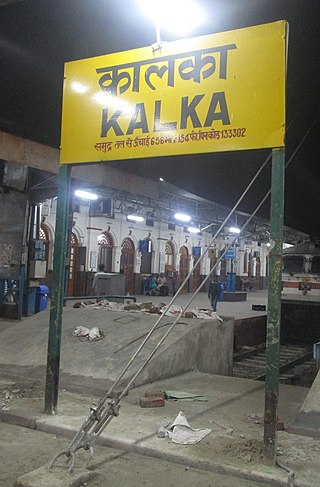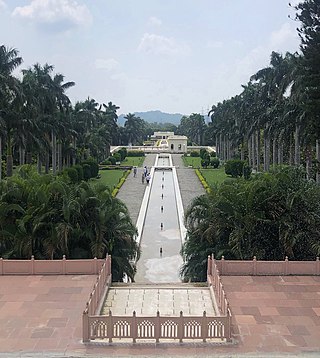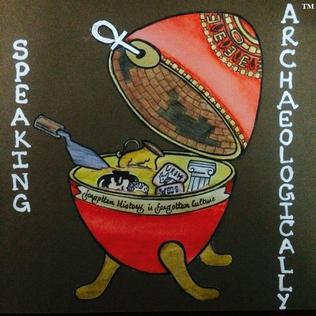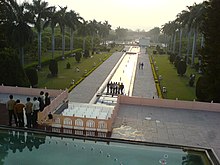
Panchkula district was formed as the 17th district of the Indian state of Haryana on 15 August 1995. It comprises two sub divisions and two tehsils: Panchkula and Kalka. It has 264 villages out of which twelve are un-inhabited and ten wholly merged with towns or treated as census towns according to the 1991 census. There are five towns in the district: Barwala, Kalka, Panchkula, Pinjore and Raipur Rani. The total population of the district is 319,398 out of which 173,557 are males and 145,841 are females.

Kalka is a town in the Panchkula district of Haryana, India. It is near Panchkula city. The name of the town is derived from the Hindu goddess Kali. It is situated in the foothills of the Himalayas and is a gateway to the neighboring state of Himachal Pradesh. It is on the National Highway 5 between Chandigarh and Shimla, and it is the terminus of the Kalka-Shimla Railway. To the south of Kalka is Pinjore, and the industrial village of Parwanoo is to the north on NH 22. Railways and Industrial development have led to a continuous urban belt from Pinjore to Parwanoo, but Kalka gained major economic benefits due to only highway until 2010, Shimla. It is the tehsil of 253 nearby sub-villages. Nearby is Chandimandir Cantonment, where the Western Command of the Indian army is based. In 2013, the municipal committee of Kalka was dissolved and the administration was reassigned to Panchkula Municipal Corporation.

Panchkula is a planned city and district headquarter in the Panchkula district in Haryana, India. Panchkula is a border city with Punjab, majority of the population belongs to Punjabi community. The origin of the name Panchkula came from the place where five irrigation canals meet. At present, it forms a part of an adjoining area to Chandigarh, Mohali, and Zirakpur. It is approximately 4 km (2.5 mi) southeast of Chandigarh, 105 km (65 mi) southwest of Shimla, 44 km (27 mi) from Ambala and 259 km (161 mi) northeast of New Delhi, the national capital. It is a part of the Chandigarh capital region or Greater Chandigarh. The Chandigarh-Mohali-Panchkula metropolitan region collectively forms a Chandigarh Tricity, with a combined population of over two million.

Yadavindra Gardens, also known as Pinjore Gardens, is a historic 17th century garden located in Pinjore city of Panchkula district in the Indian state of Haryana. Panchkula city is nearby it. It is an example of the Mughal gardens architectural style, which was renovated by the Patiala dynasty Sikh rulers. The garden was built by Fidai Khan.
Meham, also spelled Maham, is a small city in Rohtak district of the Indian state of Haryana. It is one of the two sub-divisions in Rohtak district. As a tehsil, it is further divided into two community development blocks, Maham and Lakhan-Majra.

Parwanoo or Parwanu is a municipal council in Solan district in the Indian state of Himachal Pradesh. It is an industrial town. It has Himachal's biggest wholesale market. It borders Panchkula district of Haryana, and is after the towns of Pinjore and Kalka on the Chandigarh Simla Highway. In fact it is separated by a river bed from the town of Kalka.

Raipur Rani is a census town in Panchkula district in the Indian state of Haryana. It is located on the Panchkula city-Chandigarh-Nahan-Paonta Sahib-Dehradun highway 30 kilometres east from the Chandigarh-Mohali-Panchkula urban cities combine. It is about 20 kilometres from the Dera Bassi Industrial belt and 10 kilometres from the Barwala industrial estate. Narayangarh in the Ambala District is the next large town in its proximity.

Chandimandir Cantonment is a military cantonment of the Indian Army located in Panchkula district at the foot of the Sivalik Hills adjoining Panchkula city in Haryana. It is the headquarters of the Western Command of the Indian Army.

Haryana Tourism Corporation (HTC) was constituted as a Public Limited Company under the Companies Act, 1956 on 1 May 1974. As an agent of the Government of Haryana, Haryana Tourism Corporation runs and maintains 44 Tourist Complexes spread across the state of Haryana. These Tourist Complexes offer visitors lodging, dining, recreational activities, Restaurant, Bars, Liquor Vends, Tourist taxis, Petrol Pumps, Swimming Pool, Health Club, Golf Club, Lakes, boating, etc.

Chandi Mandir is a Hindu temple dedicated to Chandi the goddess of power, near Chandigarh, located on NH-5 Chandigarh-Kalka highway in Panchkula city of Haryana state of India. It is about 15 km from the city of Chandigarh, which was named after the temple, and about 10 km away from the Mansa Devi Shrine. The temple is situated amidst beautiful surroundings and the backdrop of the Shivalik hills.

Chandigarh Capital Region (CCR) or Chandigarh Metropolitan Region (CMR) is an area, which includes the union territory city of Chandigarh, and its neighboring cities of Mohali, Kharar, Zirakpur, New Chandigarh (in Punjab) and Panchkula, Pinjore, Kalka, Barwala (in Haryana). Chandigarh Administration, Greater Mohali Area Development Authority (GMADA) and Haryana Urban Development Authority (HUDA) are different authorities responsible for development of this region. Baddi, an industrial town in nearby Himachal Pradesh, is also adjacent.

Mata Mansa Devi is a Hindu temple dedicated to goddess Mansa Devi, a form of Shakti, in the Panchkula district of the Indian state of Haryana. The temple complex is spread of 100 acres (0.40 km2) of the Shivalik foothills in the village of Bilaspur, near Sector 13 of Chandigarh, and Panchkula, 10 km from Chandi Mandir, another noted Devi shrine in the region, both just outside Chandigarh.

The Bhima Devi Temple Complex, nicknamed Khajuraho of North India for its erotic sculptures, comprises the restored ruins of an ancient Hindu temple dating from between 8th and 11th century AD, together with the adjacent 17th-century Pinjore gardens, located in Pinjore town in Panchkula district of the state of Haryana, India. The old temple was destroyed by Islamic invaders and the present 8-11th CE temple is likely built on the same place under the old name, and the nearby ancient baoli still has old Hindu pillars. Bhimadevi belongs to the Shakti tradition that was derived from the Buddhist tantric goddess. Further, in the Devi Mahatmya it is said that in the Western Himalayas of Himachal Pradesh, Bhimadevi appeared in an enormous form of Bhimarupa and gave protection to the sages. The site was worked upon extensively by the team of Speaking Archaeologically from 2017 to 2019, with preliminary survey beginning as early as in 2015 and the report was published as the Speaking Archaeologically Journal Volume III:Bhima Devi Project Edition in 2020.

The following outline is provided as an overview of and topical guide to Haryana.
Bir Shikargah Wildlife Sanctuary is situated in Panchkula district of Haryana state, India. It is spread over an area of 767.30 hectares. It also houses Vulture Conservation and Breeding Centre, Pinjore.

National Highway 5 (NH5) is a primary national highway in India, running from West to East, connecting Firozpur in Punjab to the Sino-Indian border at Shipki La. The highway passes through Moga, Jagraon, Ludhiana, Mohali, Chandigarh, Panchkula, Kalka, Solan, Shimla, Theog, Narkanda, Kumarsain, Rampur Bushahr and continues along the Sutlej River till its terminus near the Tibet border.

The Kalayat Ancient Brick Temple Complex is a ruined brick temple complex north of Delhi, is located in Kalayat town in Kaithal district of the state of Haryana, India. It comprises the several Hindu temples, including two ancient temples dating from the 8th century. This temple constitutes an important point in the series of 48 kos parikrama of Kurukshetra. Tradition avers that the temples are associated with the Shalivahana.
Tourism in Haryana relates to tourism in the state of Haryana, India. There are 21 tourism hubs created by Haryana Tourism Corporation (HTC), which are located in Ambala, Bhiwani Faridabad, Fatehabad, Gurgaon, Hisar, Jhajjar, Jind, Kaithal, Karnal, Kurukshetra, Panchkula, Sirsa, Sonipat, Panipat, Rewari, Rohtak, Yamunanagar, Palwal and Mahendergarh.
Haryana State Directorate of Archaeology & Museums is a ministry and department of the Government of Haryana in India.

Speaking Archaeologically is an archaeological education group, based in India. Founded by Shriya Gautam—alongside colleagues Lyn Pease, Catherine Holtham-Oakley, Max Zeronian-Dalley and Molly Lockeyear–in June 2015, it focuses on the documentation of neglected and forgotten archaeological sites, object analysis, and rescue archaeology.




















